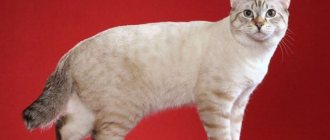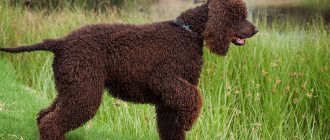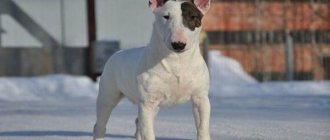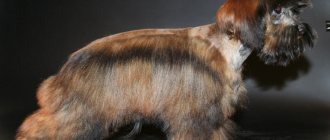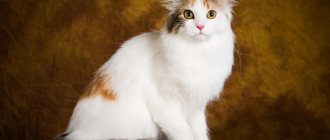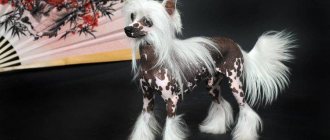Video
* We invite you to watch a video about the American Bully . In fact, in front of you is a playlist in which you can select and watch any of 20 videos about a given dog breed by simply clicking on the button in the upper right corner of the window. In addition, the material contains quite a lot of photos. By looking at them you can find out what an American Bully looks like.
In this article:
|
Rate the material!
[Total votes: 2 Average: 5]
The American Bully is a wonderful dog in every way. Representatives of this breed are sociable and friendly, happy to make contact and adore their owner. Despite their menacing appearance, they pose no threat to humans and are excellent companions. If the owner loves his bully and takes care of him, then in return he will invariably receive endless devotion and sincere canine love from the pet.
Origins of the American Bully
The American Bully is a young selective breed. The history of its origin goes back no more than three decades. However, the ancestors of the breed have been widely known for a very long time and have been popular among dog breeders for at least two centuries.
We are talking about the famous fighting dog breeds - bull terriers and Staffordshire terriers. When the latter moved to the United States, they became known as American Pit Bull Terriers. These are real fighters, bred and raised for the purpose of participating in bloodthirsty competitions and winning in underground sweepstakes. The fighting qualities of these dogs were cultivated to the maximum, so ferocity and aggression are firmly ingrained in their genetic blueprint.
Interesting fact: In connection with the introduction of bans on many types of cruel entertainment involving animals, breeders began to think about creating a new breed that would be an improved version of the existing ones. It was supposed to be a companion dog that would still have a fearsome appearance, but would also become docile and friendly.
Breeding work began in the nineties of the last century. The task was very difficult, since the “material” for creating the breed was not ordinary decorative breeds, but real fighters, ferocious and aggressive. Breeders spent several years eradicating this total aggression in the character of dogs.
Since breeding work was carried out in different regions and breeders did not exchange information about successes with each other, it is now difficult to find reliable information about the ancestors of the American Bully. The founders of the kennels stubbornly denied the use of controlled matings between representatives of more than two breeds. However, not only the pit bull terrier and the Staffordshire terrier, but also the French and English bulldogs are officially considered to be the potential progenitors of the breed. The new breed acquired the sonorous hooligan name “bully”, which translated means “bully”.
In the United States, the American Bully breed was officially recognized in 2004, but recognition has not yet taken place at the international level. And this despite the active growth in the number of representatives of the breed and its growing popularity every year.
Description of the breed
The American Bully exterior standard has not yet been accepted internationally (FCI), but since July 1, 2013, the United Kennel Club has approved a national breed standard.
This is a small dog, but with developed muscle mass and a square head.
The heavy bone does not prevent the dog from moving freely.
The body and head look massive, which distinguishes the breed from the rest. The ears are set high and erect naturally, but most breeders crop them.
Eyes can be any color, but only without signs of albinism.
A clearly defined massive mouth with tightly fitting lips, an attentive and intelligent expression.
The nose is dense and large with wide nostrils - it allows the bully to breathe well and be resilient.
A strong neck without sagging skin looks powerful and businesslike.
Large, athletic shoulders extend into strong, short legs.
The dog's bulky body looks intimidating, but without excesses. A well-developed chest with widely spaced paws reveals the fighting past of the American Bully's ancestor, the pit bull.
A square physique should be balanced with the muscles of the limbs.
The medium-sized tail is set low , lowered when calm, and raised up when excited.
The coat is short, dense, pleasant to the touch and has a varied range of colors; only the “Merle” color is unacceptable.
The American Bully should be fit and sporty with no signs of obesity.
Types of American Bully (descending):
- type XL – male height 51-58 cm, female height 48-56 cm at the withers;
- standard (eng. standard) – male height 43 – 51 cm, female 40 – 48 cm;
- classic (English classic) - more slender compared to the standard type, but the height at the withers is the same - height for males is 43 -51 cm, for females 40 - 48 cm;
- pocket (eng. pocket) male height up to 43 cm, female up to 40 cm at the withers.
The standard type is the basis of the breed.
The American Bully Pocket is lower than the Standard Bully, and the XL type is taller than the Standard type, the Classic type is lighter in weight.
Main disqualifying signs:
- aggressive or cowardly behavior;
- albinism;
- merle color;
- cryptorchidism;
- deafness.
American Bully - description of the breed
Breeding work to create American bullies was carried out separately; breeders did not strive to unite in clubs and groups and did not share the results of selection. For this reason, the appearance of the representatives of the new breed was very diverse. Dogs varied not only in size - from quite large to very miniature animals, but they also had different body proportions. In addition, one could count more than ten color options for dogs.
The similarity of the new breed with Amstaffs and pit bull terriers caused a flurry of indignation on the part of owners of fighting dogs, who believe that such unceremonious interference introduces enormous confusion into the process of their breeding. There was a need to streamline bully breeding work in order to define and officially recognize breed standards.
American bullies are vaguely similar in appearance to their ancestors - pit bull terriers and amstaffs. But they are stockier, stronger and have a more powerful build. Despite their muscularity, bullies are agile and compact, and therefore often surpass fighting dogs in strength, speed and endurance. The American Bully is a medium-sized breed.
Depending on the height at the withers, the standard defines four categories of dogs:
- Standard. The category has the maximum number and is considered the standard of the breed. The height of animals at the withers ranges from 40 to 51 cm. Males, as a rule, are larger than females;
- Classic. Dogs in this category differ from “standard” representatives by being very similar to pit bull terriers and staff dogs. Animal growth corresponds to the “standard” category;
- XL are the largest representatives of the breed. The height at the withers in males reaches 57 cm;
- Pocket bullies. The appearance of the representatives of the category absolutely corresponds to the “standard”, with the exception of their height, which is 33-43 cm.
The weight of dogs also depends on the height at the withers, which varies from 30 to 58 kg. This is the official classification of American Bullies. Previously, there was a fifth category - “Extreme” - but it was abolished at the request of the American Bully Kennel Club.
American Bully: characteristics of the breed
For show dogs (and simply to determine a healthy, full-fledged animal), there are certain standards of appearance. For males and females they are slightly different, since sexual dimorphism in the breed is moderately, but clearly expressed.
In general, a sign of health for such dogs is a strong and athletic appearance - sufficient muscle mass, the absence of any congenital injuries or imbalances. Although these animals have a powerful chest and from a distance they may seem a little unbalanced in their physique, this is not the case - the American Bully dog is as agile and fast as it is strong.
Disqualification of a dog is possible only in cases of serious deviation from the characteristics of the breed accepted by the organization, injuries that prevent the animal from conducting full physical activity, or illness.
Head
It is by the head that the bully breed is most often distinguished - this is the breed standard of paramount importance. Like similar breeds (Bull Terrier and Staffordshire Terrier), the head is large, powerful, with strong jaws. The head should not be disproportionate to the rest of the body, and should not have wrinkles on the cheeks. According to the standard, the jaws fit tightly to the jaws, not damp or saggy.
The American Bully's muzzle should be no more than 35% of the total length of the head (measurements should be completed at the back of the dog's head), straight. If you take a close look at these characteristics, you will notice that the breed is strikingly different from those with whom it is usually confused.
The neck corresponds to the head - powerful, of medium length, slightly arched upward. A thin or excessively long neck indicates disease or improper breeding.
Minor appearance features:
- according to the standard, eyes should not be low-set, have a pronounced third eyelid, and also not be blue or light blue;
- ears can be cropped at the owner's discretion - this is not mandatory, but it is necessary to choose one (a dog with improperly cropped ears, that is, semi-erect, is considered non-standard).
Block (housing)
The body is wide, stable and muscular. A dog of medium height with developed muscles and a powerful chest and neck - the classic standard of the American Bully. However, there should be no excesses in the width and depth of the chest - an animal with such developmental anomalies loses dexterity and mobility.
The slope of the croup goes in the direction from the withers to the tail, it is insignificant and noticeable only in profile - in general, the line of the croup should be straight. It is easy to check the dog's proper height - you need to measure the distance in centimeters from the withers to the elbow, and then from the elbow to the toes. If the indicators match, the bully meets the standards (minor deviations downwards are acceptable).
We advise you to read: Entlebucher Sennenhund Dog Breed
The size of American Bullies can be described as medium - the dogs appear large due to their developed muscles and wide chest. In fact, the breed cannot be called a large dog.
Limbs
Thanks to their limbs, bullies can keep their balance so well and “carry” their body with a significant advantage to the front. It is not surprising that the standards clearly indicate their parameters - an American Bully with defective legs will not only be unable to perform exhibition activities, but will also experience significant difficulties in his daily life.
What definitely shouldn’t happen is a dystrophic structure of the hind limb girdle. The bully's loin is strong and deep-set, its hind legs are powerful and muscular. The bend of the hock joint is well defined, and the legs are straight from the rear angle.
The front legs are straight, firmly planted and do not “spread to the sides.”
Wool
The coat of American Bullies is exceptionally smooth and there can be no exceptions. A dog with a pronounced undercoat, wavy coat and other similar deviations cannot be considered standard. A healthy shine and uniformity of coat is required, and the dog should also be smooth to the touch.
Upon deeper analysis of the coat, it should turn out to be hard and equal in all parts of the dog’s body. A curly coat is a serious disqualification, but not as much as a long coat.
Vices
In principle, any critical non-compliance with the standards adopted by the organization can be considered a defect. In especially severe cases (or if there are several discrepancies), the dog will not be allowed to participate in competitions and other events where the breed qualities of dogs are assessed.
Critical faults for American Bullies:
- Disproportional head (too big or small).
- Weak, narrow or short muzzle, weak jaws and drooping jowls.
- Short and upturned muzzle, wrinkles.
- Crooked, poorly placed paws (front and rear).
- The weak rear is thin and lacks muscle.
- Chest too wide.
- Too tall or too short.
All of the above will definitely prevent the dog from taking prizes or near-prize places, but if it has other qualities that meet the breed standard, it will be allowed to compete (depending on the level of the event). The following points guarantee complete disqualification:
- Merle type color;
- cryptochism in males of any type;
- albinism;
- long wool;
- clear dwarfism;
- deafness;
- wide non-standard ears “flare up” (the dog cannot bring them together at the top);
- aggressiveness;
- The opposite of aggressive behavior is shyness and stupor.
The latter characteristics relate to the dog’s behavior and are no less important than external factors - socialization is strictly required for American Bullies.
American Bully height and weight
The breeder’s task when choosing a breed was to create a dog that, with all its sociable skills, looks impressive and can scare away the owner’s offender with its appearance. These pets cannot be called giants, but their weight (especially in males) can be compared to the weight of a child or a fragile woman. Thus, bullies fall into the middle weight category, adjacent to the heavy one.
The height of dogs does not exceed half a meter - all the weight is placed in the developed muscles of the animal. At exhibitions and other events where the quality of a dog is assessed, it is not so much the height and weight separately that is important, but the correct ratio of height and weight. This directly affects the coordination of the bully in space, his mobility and future state of health.
American Bully: weight and height:
- Males - from 30 to 58 kg; 43-52 cm;
- Bitches - from 30 to 40 kg; 40-48 cm;
There are many defects associated with height, the detection of which automatically disqualifies the dog - for example, dwarfism, which is a common mutation, in contrast to legs that are abnormally long for the breed.
American bully colors
Bully colors can be quite varied (excluding merle, which is prohibited for the breed), and the future owner has plenty to choose from. In terms of the variety of colors, the animals can be compared with similar “fighting” breeds, but, as often happens, only two or three gain great popularity (both common and professional). Among bullies, these are black, blue and tricolor.
Merle is prohibited for bullies for a reason. The fact is that this color appears as a result of a genetic mutation - the pigment spreads unevenly, resulting in these spots appearing, which many non-professional dog breeders consider to be an external advantage of the animal. It has been established that the genetic processes of color formation are directly related to similar processes of mental formation. Mental problems for a dog with such strong jaws and body weight are unacceptable even in theory, since people and other dogs may suffer.
Popular colors:
- Black bully. Such dogs look very impressive - it’s hard to argue with that. The combination of jet-black coat with bright and expressive eyes, typical of the breed, attracts many owners. The dog does not have to be completely black - the typical white patches on the chest and paws of different sizes are allowed.
- Blue Bully. In the taxonomy of dog colors, blue is a special shade of gray that is difficult to match with any other. Blue bullies look very regal and aristocratic, the color of their coat shimmers in the sun and the pet seems to “shine” under its rays - this is why there is such a demand for blue puppies. White patches on the chest and legs are also acceptable.
- Bully "tricolor". An unusual color, popular along with the classic options presented above. The tricolor looks very original and unusual - dogs of this color combine three colors in different proportions. White and fawn are always present, and the third color can be either black or blue. Bullies of this color are less similar to each other and can be found in different variations - a good place for choice.
We advise you to read: Skye Terrier Dog Breed
These colors are ideal for a companion dog and are familiar to the human eye. Bully owners are not forced into strict standards and have a good range of preferred colors to choose from. Albino bullies are also sold for connoisseurs, but such a dog will not be able to participate in competitions, not to mention the mass of potential problems that the animal’s lack of pigment “promises” - for example, a high probability of allergic reactions.
Popular colors of American Bullies
The American Bully is a short-haired breed. The coat of dogs is very dense, moderately hard, smooth, without undercoat. You can always assess the health of a dog by the characteristic shine of its coat. If a bully's coat loses its usual luster, this may mean that the pet is unhealthy.
Interesting fact: The American Bully breed standard allows for almost any variation in animal coat color. The only exception is merle - the so-called “marble” color.
Bully owners, of course, have certain preferences. For example, in the homeland of the breed, in the USA, the most popular colors are deep black and chocolate. According to tradition, these colors are considered the most brutal and give the appearance of their owners additional masculinity and severity.
And Europeans more often choose colors: beige, milk chocolate, smoky gray, light brown, ocher. Red bullies look very impressive; in some nurseries there are even waiting lists for red puppies. Apparently, the red “badass” looks the most authentic in the eyes of many potential bully owners.
Is it easy to train an American Bully?
American Bullies are very easy to raise and train, and they love to exercise.
The American Bully will be able to protect the owner if necessary; OKD and ZKS are successfully completed with them. But they are unlikely to guard the house, although everything here is individual.
For bullies, early socialization is very important, teaching the dog to new people and smells, and learning to be friendly towards other animals. In the process of training, it is important to establish a trusting relationship with the dog, but at the same time remain for it a leader, a leader, whose guidance it needs.
Breeder's recommendation: Bullies should be raised moderately strictly, without the use of physical force. Puppy training in commands begins at an early age at home. It is advisable to start attending obedience courses at 6 months of age.
Pictured: American Bullies
Character and habits of American Bullies
Character is perhaps the most interesting thing about representatives of the American Bully breed. For a long time, breeders tried to eradicate the total aggression inherent in their ancestors, and these efforts were crowned with success.
Stern and cocky in appearance, bullies are actually friendly and cheerful creatures with a balanced psyche. They easily make contact with others without showing the slightest aggression. They are sociable, active, love affection and enjoy being stroked and scratched.
Bullies are so sociable that they can get along in any team - be it a pack of dogs or a large human family. Sensitively sensing the atmosphere in the house, bullies show extraordinary peacemaking abilities to resolve conflicts and quarrels. They cannot stand tense situations and invariably try to defuse it with some funny prank.
They get along well with their master's children and are ready to allow them unceremonious treatment and excessive squeezing. They can play active games for hours, but never allow themselves to snap or show aggression, even in response to painful pokes.
Bullies are excellent at establishing contact with all family members, but, like most dogs, only one person is considered the real owner. It is he who the pet tries to please in order to evoke the inevitable approval and smile; he loves him endlessly and devotedly, and is always especially affectionate and attentive with him. There is no greater pleasure for this good-natured big guy than spending time with his owner, trying not to lose sight of him for a minute.
Despite its intimidating appearance and well-developed hunting instincts, the American Bully does not make an ideal guard. He does not have enough natural aggression for this purpose. But the bully defender is excellent. If one of his family members is in danger, he will not hesitate to attack the offender, no matter the size. Bully will defend his people to the last, even at the cost of his own health and life. It is difficult to find a more selfless and devoted dog in this regard.
The American Bully should not be left alone for long periods of time. Of course, he will not allow himself to damage the furniture out of resentment or howl under the door, irritating his neighbors. But bullies are still very social dogs, they become strongly attached to loved ones, need constant attention and do not tolerate separation from their owners well.
Interesting facts about American Bullies
High socialization, good-natured character and sociability made the stern-looking American Bully an ideal companion. Representatives of this breed are successfully used to communicate with people during the period of post-traumatic disorders. It has been proven that their positivity and vitality have a huge positive impact on a person’s psycho-emotional state.
Thanks to their remarkable strength, agility and endurance, American Bullies become excellent rescuers. They are selfless and brave, and will fight to the last for the life and salvation of the victim.
The American Bully is also an excellent “nanny” for the owner’s children. This patient dog is able to withstand several hours of play and not even become embittered by small “tormentors.”
It happens that bullies show aggression towards their relatives. But he will never be unfriendly to a person in the absence of good reason - deliberately provoking aggression, causing severe pain or attacking the owner.
Bully has such a strong connection with his owner that over time he takes on his character traits. Unfortunately, not only the best. And if the owner allows himself to be aggressive towards the pet, sooner or later he may encounter a corresponding rebuff.
But if a bully feels comfortable among his family members, he turns into a playful “kitten.” He will gladly fall on his back and trustingly expose his belly to you for stroking.
Proper education and training of American Bullies
Training a companion dog, which includes the American Bully, is, in principle, simplified - the dog, if the owner does not want it, has no need to learn complex elements. In everyday life, the pet will only need knowledge of basic commands and well-established human authority.
Basic education
Training a bully for the needs of the average dog owner is not much different from training other dogs that also serve exclusively as pets. You will need to learn a set of standard commands with your dog, undergo training on concentration and eliminate any beginnings of aggression towards other animals and especially towards people.
IMPORTANT! The owner of an American bully, starting from the size inherent in the “standards”, needs to pay as much attention as possible to the dog’s upbringing and, if possible, wean it from close contact with strangers - bullies look quite “menacing” to the average person and can cause increased negativity compared to other breeds.
It is also worth considering that males of the breed express more “independent activity” than females. Owners of bully males should be more attentive to their pets and establish the correct hierarchy in the domestic pack as early as possible. If developing obedience and other positive qualities in a dog is critical, it is better to contact a dog trainer for help in a basic training course.
American Bully training
An owner who is directly interested in training bullies will have a little more difficulty with the freedom-loving temperament of these dogs. If the owner’s authority is not established in time, only a course with a dog handler can correct the wayward, strong dog.
We advise you to read: Dog breed Kurzhaar (German shorthaired pointer)
To achieve an ideal result, you should contact a specialist with your puppy. Contrary to popular myth, a dog trainer exists not only to correct dogs that make mistakes in their behavior - the specialist also works with very young dogs. A timely visit to the canine training ground will keep the animal’s psyche healthy, as will the relationship between the pet and the owner.
IMPORTANT! If you are not confident in your educational abilities, contact a dog trainer right away - retraining an adult dog (even a young one) is not easy.
Otherwise, there will be no problems with training bullies - these dogs are quite smart and happily support the game, under the pretext of which they can develop all the skills necessary for the owner. The main thing is to be persistent and set your own rules without using violence, which applies to any dog.
Pros and cons of American Bullies
Before you decide to have an American Bully at home, you need to carefully weigh the pros and cons, taking into account the characteristics of the breed.
It should be understood that despite the lack of aggression, the large dimensions of the animal can be obviously traumatic for small children or the elderly. A pet may get carried away and not calculate the consequences of comic attacks, jumping, or biting. During a walk, he may run away chasing a cat or another dog, and tugging on the leash will lead to a fall or injury.
The breed is not suitable for those with a soft character. Although the bully is usually good-natured and phlegmatic, he has a tendency to show dominance, especially if he senses some weakness on the part of the owner. Young males under the age of one and a half years are guilty of this. If you do not show sufficient firmness in training in time, the pet can completely get out of control. Therefore, you need to build the correct hierarchy, starting from the puppyhood of your pet. People who do not feel capable of this process and do not have experience in raising fighting dogs are better off choosing another breed.
Bully needs constant attention and becomes very attached to his family. He suffers from long-term loneliness, which he feels almost physically and may even become ill as a result of it. In addition, left to its own devices, the pet loses the habit of seeing its owner as a leader, loses communication with him, and this leads to problems in communication and mutual understanding.
Interesting fact: An important point when choosing an American Bully as a pet is the presence of other pets in the family.
Bullies usually get along well with them, but there are exceptions. Some young male dogs, having a particularly cocky character, can get involved in conflicts with their relatives while out for a walk, with or without reason. For such “aggressors”, the presence of decorative rodents, cats or birds in the house in addition to them is far from the best solution. It is necessary either to separate the habitat areas of these pets from the territory of the bully, or to exercise extreme vigilance, carefully monitor the behavior of both and avoid conflicts.
By their nature, bullies are not overly active animals, but they also cannot be called “sofa cushions”. To satisfy the need for physical activity, “Americans” need a one-and-a-half-hour walk twice a day. But a bully will never give up adventures and new experiences, so any outings into nature together with the owner - a country trip, a hike, fishing - bring a lot of positive emotions to the cheerful and curious bully.
What is the character of an American Bully?
Our bully has grown up - grown up, but not matured. The girls are younger and their character is still being formed, but the boy is a big doll, absolutely harmless, kind and very vulnerable.
According to my observations, bullies are physically formed by the age of 3, but psychologically mature much later. Even though my male dog is almost 4 years old, he still acts like a puppy.
Breeder's observations: Bully dogs do not have aggression at the genetic level. They are very good-natured towards people - this is the result of a long, purposeful selection, but, despite years of work by breeders, zoo aggression was not completely “removed”. My male dog won’t even understand if someone attacks him: he will think that they are playing with him, but the girl will stand up for herself.
Bullies can and should be taken into a family with children, even small ones - these dogs will not offend either an adult or a child and love to participate in children's games. Before choosing this breed, study the history of the American Bully. You should also pay special attention to the appearance of the puppy’s parents - they must meet the American Bully breed standard.
In the photo: American Bully puppies
Breeding American Bullies
The process of breeding American Bullies is no different from representatives of other breeds. The bitch is ready for mating at the age of one year. But, as is known, on European territory the number of the breed is extremely small, and the choice of a partner for mating may be associated with the problem of the presence of closely related ties.
For blood purity, the main condition for breeding high-quality offspring is the careful selection of a breeding pair. A breeder who does not have experience in breeding such breeds is unlikely to cope with such a task on his own. In this case, you will need professional help from representatives of officially registered nurseries.
Since American Bullies, even with strong immunity, are not immune from genetic diseases, it is necessary to carefully track the heredity along both parental lines of the couple.
It is necessary to make sure that there are no ailments such as:
- Optic nerve atrophy, cataract;
- Joint dysplasia;
- Cardiovascular diseases.
Producers must be of reproductive age, be absolutely healthy, and must undergo the required vaccination and antiparasitic treatment.
An American Bully female can give birth twice a year. However, such a frequency of reproduction of offspring will affect the health of the mother in the most negative way. Her body quickly wears out and does not have time to properly recover between births. And this will certainly affect the health of future puppies. Therefore, breeding matings are carried out once a year, not more often. In this case, the bitch has time to feed the offspring and restore her own strength and health.
Usually 2-4 American Bully puppies are born in one litter. Larger litters often produce more breeding, and the puppies in such litters are not very strong.
Proper education
Raising an American Bully at home is not difficult - an intelligent dog quickly understands what its owner wants from it. From the first days, accustom your pet to a place, a toilet, and a feeding schedule. Buy toys so that your baby doesn't get bored when the family isn't around. Set rules of behavior and do not break them yourself.
How and when to educate:
- at 2 months, the puppy is toilet trained, collar trained, prohibitions are indicated (no on the bed, no asking for food from the table), taught the first commands - “place”, “no”, “to me”;
- from 3 months (after vaccination and quarantine) - socialization. This is an important element of education that shapes correct behavior in different conditions. If a bully treats people favorably, disagreements may arise with other animals. Accustom your puppy from childhood to the company of dogs and cats. At this age, the puppy easily develops conditioned reflexes, so you can begin to train for real - teach important skills;
- by 4-5 months, your pet should be able to walk next to you, return to you on demand, follow the “wait” command, not pick up crap from the ground, stop barking on demand;
- at six months the puppy begins puberty - stop the “rebellion”, but do not use physical punishment. Put the dog “in its place”, achieve obedience, do not show weakness, otherwise your authority will be undermined. At this time, all the shortcomings in raising an American Bully puppy are clearly visible. If you cannot correct them yourself, we recommend that you take a behavior correction course at our center taught by professional trainers.
Caring for American Bullies
Caring for American Bullies is easy. In essence, they require the same hygiene procedures as most other shorthaired breeds.
It is precisely because of the presence of short hair that bullies do not need thorough daily combing. It is enough to carry out this procedure once a week using a brush with coarse bristles. And only during seasonal molting is it advisable to comb your pet twice as often.
Frequently bathing an American Bully is also not necessary and even harmful. If you do this more than twice a month, your pet’s fur will lose its natural protective layer of fat. In this case, the functioning of the sebaceous glands is disrupted, which can lead to the appearance of a specific odor, which is subsequently very difficult to get rid of.
If the coat looks dirty, you can wipe your pet with a damp cloth or even use dry shampoo. And water treatments can be done when the bully is really dirty. In this case, you should use mild hygienic detergents or special shampoos for short-haired dogs (without alkalis and acids), rinsing them off with warm water. Bullies usually tolerate bathing well and even get a lot of pleasure from it.
But they don’t really like blow-drying. And since short hair dries out quite quickly, you can simply dry your pet with a towel after water treatments and leave it to dry naturally. The only condition that needs to be ensured in this case is the absence of drafts. Although bullies are distinguished by the presence of a very strong immune system, they are still not immune to colds.
Important fact: A special area of attention is the eyes and ears of the American Bully. They must be inspected daily to ensure they are free of infections and parasites. Ear cleaning should be done as needed, without using cotton swabs. Dirt and dust are removed with a damp cotton swab, and this must be done carefully so as not to injure the animal’s ear or cause an infection.
The eyes of a healthy bully do not require special care, except for the usual wiping with a damp cotton pad. If excessive tearing or redness occurs, you should consult a veterinarian for advice.
Due to the anatomical structure of the oral cavity, American Bully teeth are susceptible to plaque formation. To maintain their cleanliness and hygiene, you will have to use special products - toothpaste for animals and a toothbrush (or a finger attachment). In addition, to prevent plaque formation and strengthen teeth, you should give your pet dog treats made from pressed bones or silicone toys. At the same time, it is necessary to choose safe and environmentally friendly hygiene items so as not to inadvertently harm his health.
And of course, dog paws also need care. The American Bully needs to periodically trim its claws, which do not have time to wear down on hard surfaces even in the most active representatives of the breed. And in winter, it is necessary to inspect the paw pads more often so that the chemical reagents and salt that are sprinkled on icy roads do not cause a chemical burn. Bullies are very patient creatures with a high pain threshold, so they may not show that they are experiencing discomfort or pain for a long time.
How to care for an American Bully?
To keep dogs of any breed in good shape and in good physical shape, it is necessary to give them physical activity. Bullies are no exception, but in hot weather my dogs have limited walking; I try not to strain them in the summer, since the dogs are massive and heavy, and the cardiovascular system may suffer. We specifically moved to a private house for them so that they could spend as much time as possible outside.
American Bullies do well in apartments. Outdoor housing and an enclosure are absolutely not suitable for them - this is fraught with hypothermia and joint disease.
Pictured: American Bully
And, of course, good nutrition. It is also necessary to give vitamins and chondroprotectors to support joints.
Breeder's recommendation: My puppies eat dry food until they are 1 year old, and after 1 year they switch to natural feeding. 75% of the American Bully's diet is meat, 15% is vegetables and fruits, and the rest is carbohydrates. Each adult dog eats 1300 g of meat per day.
In summer, bullies eat 1-2 times a day (due to the heat they have a poor appetite), the rest of the time - 2 times a day.
Pictured: American Bully
American Bully diet
For proper development and full health, representatives of the American Bully breed need good nutrition. If you don't pay enough attention to this aspect, you can create a lot of problems for your pet. The owner's responsibility in this matter should be at its best.
Whenever it comes to the nutrition of our little brothers, there are ardent supporters of industrial food and those who prefer to feed their pet exclusively natural food. It is high time to stop the debate on this topic by defining a balanced diet as the main criterion for feeding a pet.
Industrial feeds have undeniable advantages. They contain carefully selected nutrients, vitamins and microelements, all in the correct proportions and sufficient quantities. The owner who chooses this method of feeding will not have to use additional food additives. It is only necessary to provide your four-legged friend with a sufficient amount of fresh water, which a dog eating commercial food should always have free access to.
Food for American Bullies must be selected from the premium category. Their quality will allow you to avoid problems in the form of allergic reactions and other possible adverse consequences. In the matter of choosing the right industrial food for a particular dog, the help of a qualified specialist is very welcome.
If the choice is made in favor of a natural diet, then it should consist of dietary meat and a mixture of three main cereals - rice, buckwheat and millet. In this combination, your pet’s lunch will be the most complete. When preparing food, do not use salt or spices. This is the basis of the American Bully menu.
But it needs to be diversified with the following permitted and useful additions:
- Low-fat fermented milk products (2-3 times a week);
- Seasonal fruits and vegetables;
- Vegetable oil (one tablespoon per day);
There is, of course, a list of prohibited foods that should never appear in a pet’s bowl, regardless of age.
This is, first of all:
- Any food from the host's table;
- All types of sweets, especially chocolate;
- Potato;
- River fish in any form;
- Fatty, spicy and pickled foods;
- Whole milk;
- Citrus;
- Onion and garlic;
- Mushrooms.
From the age of weaning, American Bully puppies should be fed at least 5 times a day. Then gradually the number of meals decreases, and an adult one-year-old dog needs to be fed only twice a day - in the morning and in the evening. It should be borne in mind that American Bullies are prone to gaining excess weight, so food portions should be moderate, and daily exercise should be mandatory.
Maintenance, feeding and care
This is a heat-loving nature - the bully has practically no hair, he loves the warmth and comfort of a city apartment.
To maintain health, frequent long walks are required at least 3 times a day.
They bathe them about once a month, then brush them, then shedding is not a problem. Nails are trimmed as needed and ears are cleaned once a week.
Particular attention will have to be paid to the oral cavity - this breed is prone to tartar, so they brush their teeth 2-3 times a week with a brush.
Feeding an American Bully is not much different from other dogs - the diet can be based on both dry food and natural food.
When feeding natural food, it is better to use cooked beef with porridge (rice, buckwheat), cottage cheese no more than 3 times a week, fresh fruits and vegetables, and also add vitamin complexes as recommended by a veterinarian.
It is better to take premium or super premium dry food - you should not skimp on such a dog. With proper care, they will please the owner for 12-14 years.
Diseases and health problems
When creating the American Bully breed, breeders did a great job, providing its representatives with excellent genetics. The descendants of fighting dogs are distinguished by good health and enviable immunity.
But even these big guys, especially city dwellers, are subject to some ailments:
- American Bullies do not tolerate high temperatures well. Simply put, they don't like heat. Even despite the lack of long hair, bullies prefer to hide in the shade or sit at home in an air-conditioned room on hot sunny days. You can only take your pet out for a walk early in the morning or late in the evening, when the heat has already subsided. During the hot season, it is especially important to ensure that there is fresh water in the dog’s bowl so that the pet does not overheat and does not suffer from thirst;
- Optic nerve atrophy, cataract. These problems, unfortunately, are transmitted genetically, so when choosing an American Bully puppy, you should carefully study the medical records of its parents;
- Dental diseases. The anatomical structure of the American Bully's oral cavity contributes to the appearance of plaque. In the absence of proper hygiene, including daily brushing of teeth, plaque hardens and turns into tartar, which can only be removed in a veterinary clinic;
- Joint dysplasia. This disease usually appears during puppyhood. Many owners abandon puppies diagnosed with this disease, returning them to the breeder or simply throwing them out on the street. However, modern veterinary medicine offers methods for quite successful treatment of joint dysplasia. Many dogs are able to feel quite satisfactory and live rich, full lives;
- Demodecosis. A very unpleasant skin disease caused by a microscopic worm-like mite. It begins quite harmlessly with ordinary skin itching, but subsequently, without proper treatment, the disease rapidly develops, affects internal organs and can lead to the death of the animal. Quite difficult to treat.
All these possible ailments indicate that the health and general condition of the American Bully should be in the area of increased attention of its owner. Preventive examinations by a veterinarian, timely vaccinations, hygiene and proper nutrition will help keep your pet’s health problems to a minimum.

